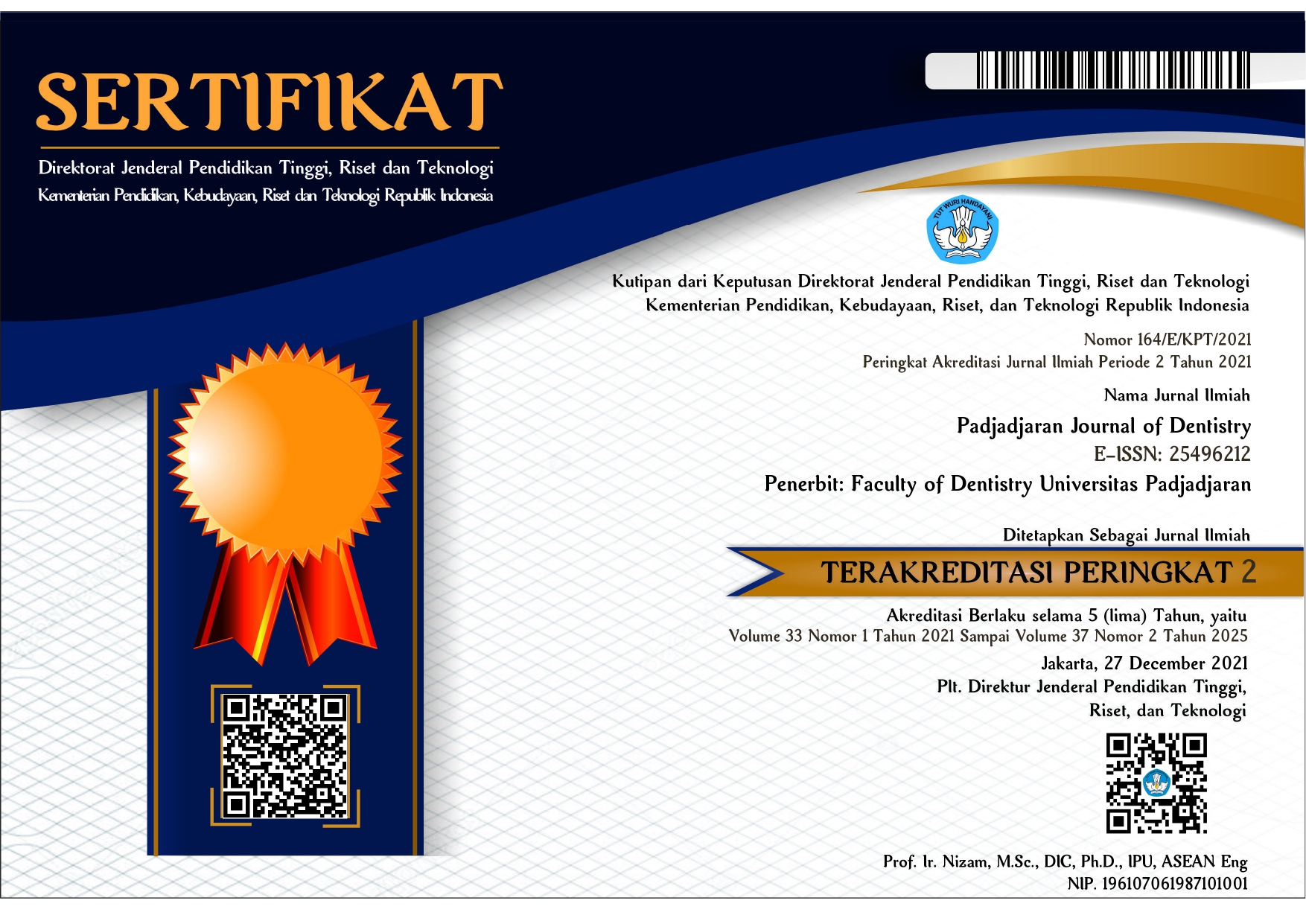Differences of Micro-CT evaluation of the obturation sealing capability between thermoplastic carrier-based condensing techniques and lateral heat condensation techniques
Abstract
ABSTRACT
Introduction: Root canal filling is an important part of root canal treatment that aimed to seal the root canal system, to prevent bacterial penetration and their toxins into periradicular tissues and to provide favourable environment for periapical healing. Thermoplasticized technique were developed to produce filling with homogenous mass, to achieve optimal sealing ability and to increase the quality of root canal filling. The aim of this study is to analyzed differences of Micro-Computed Tomography (Micro-CT) evaluation of the obturation sealing capability between thermoplastic carrier-based condensing techniques and lateral heat condensation techniques. Methods: This study was conducted under an in-vitro quasi experimental methode to 36 specimens of maxillaris centralis incisivus which were divided to 3 groups, (A) thermoplasticized carrier-based technique (GuttaCore System), (B) warm lateral condensation technique (heat carrier SystemB), (C) cold lateral condensation as control group. Sealing ability is evaluated based on the measurement results of volume percentages of filling material and sealer, volume of void, and surface density, that which was calculated from the 3D volumetric image of Micro-CT device. Data were statistically analysed using Analisis of Variance (ANOVA) and t-test. Result: The result showed significant difference of percentage filling material and sealer volume in apical third (p<0.05), whereas there were no significant differences of void volume in apical third, middle third, coronal third or along the canal (p>0.05). Conclusion: Thermoplastized carrier-based technique is not better than warm lateral technique.
Keywords: sealing ability; root canal filling; thermoplasticized carrier-based technique; warm lateral technique.
Keywords
Full Text:
PDFReferences
REFERENCES
Mustafa AS. Evaluation of density and homogeneity of three different root canal obturation techniques: a three-dimensional computed tomography in vitro study. Tikrit J Dent Sci. 2013; 3(1); 17-23.
Prasad K, Rao N. Comparative sealing ability of injectable thermoplasticised gutta percha, thermocompaction and lateral condensation in vitro study. Annals Dent Specialty. 2015; 3(1); 1-5 .
Kierklo A, Tabor Z, Petryniak R, Dohnalik M, Jaworska M. Appilcation of microcomputed tomography for quantitative analysis of dental root canal obturations. Postepy Hig Med Dosw (online), 2014; 68; 310-5. DOI: 10.5604/17322693.1095271
Chen K, Wu J, Yang H, Xu Y, Wang R, Shang G. In vitro experiments on the sealing ability by high-temperature thermoplasticized injectable techniques and cold lateral condensation. Biomed Res. 2015; 26(4); 651-5.
Alrwitai SA, Latief DA. Radiographical study of success and failure with evaluation of the causes of that failure of endodontically treated teeth. Saudi J Oral Dent Res. 2018; 3(1); 314-8.
Kierklo A, Tabor Z, Pawinska M, Jaworska M. A microcomputed tomography-based comparison of root canal filling quality following different instrumentation and obturation techniques. Med Princ Pract. 2015; 24(1); 84-91. DOI: 10.1159/000368307
Castagnola R, Marigo L, Pecci R, Bedini R, Cordaro M, Coppola EL, et al. Micro-CT evaluation of two different root canal filling techniques. Eur Review for Med Pharm Sci. 2018; 22(15); 4778-83. DOI: 10.26355/eurrev_201808_15611
Moeller L, Wenzel A, Wegge-Larsen AM, Ding M, Kirkevang LL. Quality of root fillings performed with two root filling techniques. An in vitro study using Micro-CT. Acta Odonto Scandinavica. 2013; 71(3-4); 689-96. DOI: 10.3109/00016357.2012.715192
Tomson RME, Polycarpou N, Tomson PL. Complete obturation of the root canal system. British Dent J. 2014; 216(6); 315-22. DOI: 10.1038/sj.bdj.2014.205
Kulkarni G. New root canal obturation techniques: a review. EC Dent Sci. 2017; 11(2); 68-76.
Darcey J, Roudsari RV, Taylor C. Modern endodontic principles part 5: obturation. Dent Update. 2016; 43(2); 114-29. DOI: 10.12968/denu.2016.43.2.114
Keles A, Alcin H, Kamalak A, Versiani MA. Micro-CT evaluation of root filling quality in oval-shaped canals. Int Endodontic J. 2014; 47(12); 1-8. DOI: 10.1111/iej.12269
Huang Y, Orhan K, Celikten B, Orhan AI, Tufenkci P, Sevimay S. Evaluation of the sealing ability of different root canal sealers: a combined SEM and Micro-CT study. J Appl Oral Sci, 2018; 26; 1-8. DOI: 10.1590/1678-7757-2016-0584
Yanpiset K, Banomyong D, Chotvorrarak K, Srisatjaluk RL. Bacterial leakage and micro-computed tomography evaluation in round-shaped canals obtained with bioceramic cones and sealers using the matched single cone technique. Restor Dent Endod. 2018; 43(3); 1-12.
Lone MM, Khan FR. Evaluation of micro leakage of root canals filled with different obturation techniques: an in vitro study. J Job Med Coll Abbottabad, 2018; 30(1); 34-9.
Qu W, Bai W, Liang Y, Gao X. Influence of warm vertical compaction technique on physical properties of root canal sealers. JOE, 2016; 42 (12); 1829-33. DOI: 10.1016/j.joen.2016.08.014
Abramovitz I, Prokocimer T, Metzger Z, Moreinos D, Moshonov J, Pharmacists ETR. The impact of heat and vibration on the density of root fillings produced by lateral compaction: a comparative study on artificial blocks and natural teeth . Biomed J Sci & Tech Res, 2018; 2(5); 1-5. DOI: 10.26717/BJSTR.2018.02.000819
Fragachan M, Pons M, Barriuso E, Frigola J, Ballester M, Berastegui E. Micro-computed tomography assessment of different obturation techniques for filling lateral canals . J Clin Exp Dent. 2018; 10(7); 702-8. DOI: 10.4317/jced.54806.
Gad AR, Farag AM, El-Hediny HA, Darrag AM. Sealing ability and obturation quality of root canals filled with gutta-percha and two different sealers. Tanta Dent J. 2016; 13(4); 165-70. DOI: 10.4103/1687-8574.195703
Silva EJ, Herrera DR, Souza-Junior EJ, Teixeira JM. Influence of irrigation and obturation technology on artificial lateral root canal filling capacity. Acta Odontol Latinoam. 2013; 26(2); 112-5.
Gencoglu N, Helvacioglu D, Gundogar M. Effect of six obturation techniques on filling of lateral canals. J Res Prac Dent. 2014; 2014; 1-7. DOI: 10.5171/2014.807624
Suguro H, Takeichi O, Hayashi M, Okamura T, Hira A, Hirano Y, et al. Microcomputed tomographic evaluation of techniques for warm gutta-percha obturation. J Oral Sci. 2018; 60(2); 165-9. DOI: 10.2334/josnusd.17-0092.
Nhata J, Machado R, Vansan LP, Batista A, Sidney G, Rosa TP, et al. Micro-computed tomography and bond strength analysis of different root canal filling techniques. Indian J Dent Res. 2014; 25(6); 698-701. DOI: 10.4103/0970-9290.152164
Celikten B, Uzuntas CF, Orhan AI, Tufenkei P, Misirli M, Demiralp KO, et al. Micro-CT assessment of the sealing ability of three root canal filling techniques. J Oral Sci. 2015; 57(4;: 361-6. DOI: 10.2334/josnusd.57.361.
Qassab SJ, Hadi DA, Luke AM. Evaluation of three different obturation techniques using three-dimensional cone beam computed tomography: in vitro study. Dent. 2016; 6(12); 1-5. DOI: 10.4172/2161-1122.1000403
Asheibi F, Qualtrough AJ, Mellor A, Withers P, Lowe T. Micro-CT evaluation of voids in the filling material of single-rooted teeth obturated with different techniques. J Res Prac Dent. 2014; 2014; 1-10. DOI: 10.5171/2014.556901
Naseri M, Kangarlou A, Khavid A, Goodini M. Evaluation of the quality of four root canal obturation techniques using micro-computed tomography. Iran Endodon J. 2013; 8(3); 89-93. DOI: 10.1111/iej.13615
Marroquin BB, Wolf TG, Schurger D, Willershausen B. Thermoplastic properties of endodontic gutta-percha: a thermographic in vitro study . JOE. 2015; 41(1); 79-82. DOI: 10.1016/j.joen.2014.07.004
Samadi F, Jaiswai JN, Saha S, Garg N, Chowdhary S, Samasi F, et al. A comparative evaluation of the efficacy of different obturation techniques used in root canal treatment of anterior teeth: an in vitro study. Int J Clin Ped Dent. 2014; 7(1); 1-5. DOI: 10.5005/jp-journals-10005-1224
DOI: https://doi.org/10.24198/pjd.vol34no2.41384
Refbacks
- There are currently no refbacks.
Visitor Stat

Padjadjaran Journal of Dentistry is licensed under Creative Commons Attribution 4.0 International License






.png)

















